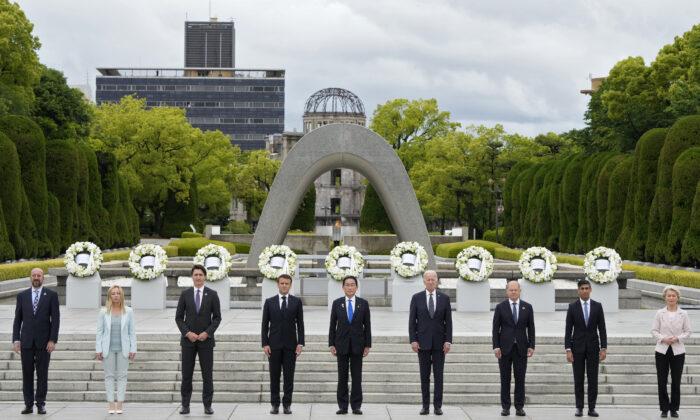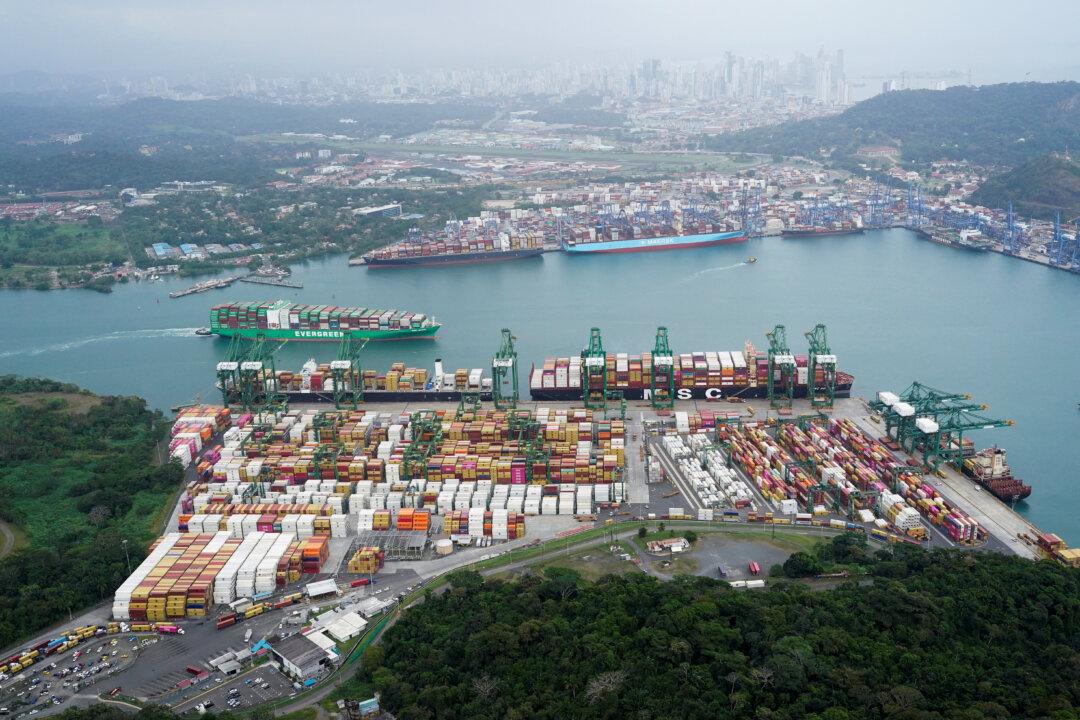The U.S.-dominated “rules-based world order” is, for the moment, dead, or at least moving into abeyance after its three-quarters of a century lifespan.
The current global strategic architecture—the framework of states and their political alignments—along with all of the accepted norms that sustain the balance of power, has already transformed to the point where all strategic presumptions must be reconsidered.
A “rules-based world order” is a historical reflection of the power structure of any given age. The current iteration is essentially the first time the phrase “world order” has been used, and the implication is that it’s an order that was essentially a universally agreed regime, a framework of behavior covered by international law. While it has nominally been a framework agreed upon by the United Nations, this “rules-based world order” was essentially defined by the Western states that won World War II, particularly by the United States.
The USSR, one of the Allied victors of that war, was included in the initial framework of the U.N. but rapidly became less influential in the “rules-based world order.”
We saw earlier iterations of regional or global dominance that extended beyond the bounds of empire: Pax Romana, Pax Britannica, and Pax Americana. Each “pax”—or peace—has been the imposition of the dominant power’s control over trading routes, currency modalities or dominance, and inter-state management rules.
These various periods of overwhelming dominance by a single patron have usually been regional, as we could have named a Pax Sovietica in Eastern Europe and the old Russian Empire regions—and elsewhere in the world—from 1945 to 1990.
But it was with Pax Britannica that a global structure began to emerge, and it was consumed and consolidated by Pax Americana as the tacitly agreed successor to the British Empire.
Understanding this evolution is critical to comprehending where the world will move next. The attendant creature organizations of the present order, such as the U.N., have already moved into ineffectual status. They provided only a fig leaf of protection or legitimacy to societies.

The League of Nations, founded in 1919 with the same purpose as the U.N., became a phantom organization when it failed in 1935 to stop the Italian invasion of Ethiopia. The league, like the U.N., was to have been an instrument to create the post-World War I “rules-based world order”; it had little success, but it provided the vehicle to start the move from Pax Britannica to Pax Americana.
And Pax Americana assumed—without the cost and labored time of empire-building—the mantle of the British-dominated era. Few appreciated the magnitude of the bequest.
So the world moved seamlessly, with World War II in particular, from Pax Britannica to Pax Americana.
The crumbling now of Pax Americana hasn’t been determined by an aspirant power to create a new global dominance system. It has largely been determined by the exhaustion of the U.S. and Western systems. Yes, Beijing has visions of a new Pax Sinica, going much more comprehensively into the world than the Han Dynasty (202 B.C.–220 A.D.). That earlier Pax Sinica covered much of East Asia.
It’s too early to determine whether Pax Americana might transform into something new or whether this present period of tenuous “primus inter pares”—first among equals, to which Pax Americana has degenerated—long prevails for the United States to dominate the structure of global “rules.” There’s still incredulity within much of the U.S. polity that the U.S. era is transforming, just as there was (and in some areas remains) incredulity in some British circles that Pax Britannica has slipped away.
Even within some Turkish circles, there’s the belief that modern Turkey retains the same international authority once enjoyed by the Ottomans, whose remaining vestiges of regional dominance were crushed finally with World War I. What remains after each of these great eras, however, are dreams of past greatness.
There are today, however, no certain or clear “rising powers.” Indeed, the “rising power” isn’t communist China, although a number of the traditional major powers are in a state of strategic flux: the United States, the European powers (including the UK), Russia, Japan, and China. India, in particular, is attempting to evolve into a major regional power, covering the Indian Ocean and South and Central Asia.
But the “inter-pax” eras have always been clouded and mired in inertia. The mists clear only gradually.
The move to a new global cold war structure—Cold War II—began when successive U.S. and allied governments began re-isolating Russia in some simplistically based reflection of Cold War I. This was crystallized with the denouement of the Russia–Ukraine war’s kinetic explosion of February 2022. There’s no going back from this, and the scramble then was for many states (including China and Russia) to claim or reclaim older or even ancient territorial blocs of alliances, trading partners, and security dependencies.
The reshaping of the G-7 (Group of Seven richest nations) to exclude China and Russia was part of this, as was the May gathering of the leaders of the five Central Asian states in Xi’an, China, attempting to pull those states—formerly dominated by the Russian and Soviet empires—into Beijing’s orbit.

The restructuring of the global balance is creating a system already vastly different from Cold War I in terms of geopolitical alignments. It will be primarily determined by a return to fluid power projection modalities more akin to those of the 19th century rather than the 20th century. It’s a return to the competition between the maritime and heartland powers, with each—as in earlier history—competing to gain footholds in the others’ domains.
Traditional heartland or land-oriented continental powers attempt to gain the capability to project maritime power. Traditional maritime powers attempt to gain land-based power projection. But the availability of air and space power projection is open to all.
The combined logistical capability across the military and civilian spectra created the transition in the 20th century from Pax Britannica to Pax Americana and sustained and compounded U.S. dominance of the global supply chain. The Royal Navy had similarly and earlier ensured the acquisition and maintenance of Pax Britannica, moving into the beginnings of the age of air power. Still, air power dominance and then space dominance essentially secured the transition, supported by the literal transfer of maritime space from Britain to the United States.
In the past, global dominance necessitated the primacy of true maritime power. By the mid-20th century, it required both maritime and air power. By the start of the 21st century, it was already clear that it required maritime, air, and space dominance. And all of this must be consolidated by terrestrial power to control domestic populations, to ensure that global or strategic power isn’t hollow at home.
Global dominance must also be knitted together by a psychological strategy to achieve and consolidate internal and external meaning and prestige to the physical dominance.
Little wonder that China, to a far more conscious degree than its former “frenemy,” the USSR, has deliberately planned a global strategy over recent decades to put in place the core framework of global supply chain assets, particularly in the form of managing, owning, and controlling ports around the world: in Southeast Asia, Australasia, Oceania, the Indian Ocean rim, Latin America, West and East Africa, the Mediterranean, the Atlantic, and so on. Similarly, China has attempted to surpass the West and Russia in controlling space.
A key aspect of this is that China has thought about what it takes to create a new Pax Sinica.
The Chinese Communist Party’s (CCP’s) specific declaration of war on the United States in 2018 was couched expressly in those terms but was completely ignored or misunderstood in the West. Essentially, CCP leader Xi Jinping said in September 2018 that it was already waging a “new Thirty Years War” against the United States, drawing a parallel with the earlier Thirty Years War, which ended in 1648 with the Peace of Westphalia. He indicated that the “new Peace of Westphalia” would—as the original did—create a new global framework and “rules-based world order,” but this time based on Beijing’s control of the rules.

Most Western strategists and analysts have forgotten the origins of the modern “rules-based world order” and how the Treaty or Peace of Westphalia shaped agreement on its architecture. Subsequent conflicts—particularly World War I and World War II—shaped how that would evolve through Pax Britannica and Pax Americana and how the first Cold War (1945–1990) confirmed Pax Americana. By then, the United States had taken its global domination of the supply chain, politics, and wealth for granted.
China didn’t take it for granted and had, particularly during the post-Mao Zedong eras, attempted to emulate through planned actions what had either evolved organically for the United States or also had, in part, been “handed to it on a plate” from the strategic space bequeathed reluctantly to it by an exhausted Britain. It may be fair to say that, after a wasting slumber of almost a century, Britain is now reawakened and contemplating the reconstruction of its strength.
What, then, can we expect of the future?
The current period of inertia has been underway for more than a decade. It could conceivably last another decade or two, or be interrupted by an accidental discharge of violence, desperation, or a sense of opportunity. Such events as the start of actual hostilities between Russia and Ukraine in February 2022 are punctuation in the process.
It wouldn’t be unreasonable to characterize the present position as akin to being in an aircraft on the edge of a stall, hanging without power after running out of the energy to climb, awaiting the sickening fall of the nose and the start of a spiraling descent.
The first obligation in a situation of imminent danger or lack of control is to regain control of immediate surroundings and to stop the economic and political descent. Someone (in each society) has to assert clear control. The longer that lack of clarity prevails or for discussion to be diverted onto tactical topics, the more disadvantage accrues to society.
The second obligation, having stabilized the decline and having acquired a revival of economic power, is to begin to regain spatial awareness—strategic situational awareness—to determine how to defend against a collision with foreign powers and identify opportunities for national reassertion. In tomorrow’s world, this will require the acquisition, or reacquisition, of effective and assertive maritime and air and space power, including the hybrid areas of missile warfare in space, atmospheric, and undersea realms.
The dominance of the seaways, airways, and space can’t be taken for granted and requires conscious integrated strategic planning. Space has long since ceased to be a neutral zone.
Given that the global and regional systems are in a state of flux as a result of the end of Cold War I, it requires navies and air forces that are geared to assertive dominance, married to corresponding civil logistical infrastructure and capabilities, as well as to markets, to transform maritime, air, and space dominance into the umbrella for trade dominance: wealth and economic security.
And today, it’s then essential that space dominance provide secure support to the communications, situational awareness, and energy and manufacturing processes critical today to make air, maritime, and ground dominance possible. Thus, command of advanced cyber and computing capabilities is no longer optional, particularly in societies heavily dependent on credit-based economies.
This integrated strategic planning is absent from all Western power centers; indeed, it’s absent from virtually all lesser powers. It requires a conscious framing of a national grand strategy. And it’s particularly incumbent on smaller sovereign societies that have hitherto compromised their nominal sovereignty by allowing major powers to dictate to them the “rules” of the world.
The bottom line, particularly during the period of inertia, is that security and basic welfare can’t be taken for granted. Since 2022 in particular, but perhaps since about 2018 in earnest, China has begun attempting to gain better control over its “supply chain” to better defend against the impact of Western financial sanctions and the tightening of foreign supplies of food, vital technologies (such as advanced computer chips), energy, and access to hard currency.
Much of Europe, too, has found that it must now consider how to take control of its access to its strategic needs and awaken to a world in which supply lines are now no longer guaranteed for commodities vital to survival, particularly energy. It has also awakened to the reality that the NATO structure, which once provided some measure of the dominance of the supply chain, is no longer meaningful. NATO continues to exist and expand but no longer has any meaningful operational or deterrence capability.
The evolution to the next “pax” may well not be to a new global regime, such as a projected Pax Sinica. It may well be to a series of regional orders. Indeed, even Cold War I could be said to have created two rules-based orders, one dominated by the United States and the other by the USSR, at least until 1990–1991. The period of Pax Americana—which provided a true “rules-based world order” and only took true global effect with the end of the Cold War for a few brief years—may well have been a historically microscopic Camelot or artificial period.
It’s possible that we may not return for some time to a new global “order,” and preparations must be made for that contingency. As well, with the fratricidal self-destruction of many societies, it’s probable that significant economic stress will disrupt the evolution of some newer, proposed weapons, computing, and manufacturing capabilities. Thus, we may see a plateauing of defense and space capabilities while overarching power evaporates.
Would this define a “new Dark Age,” or merely a different set of paths and options for societies, requiring that real, sovereign authority devolves once again into smaller (less than superpower) societies? The final collapse of the Western Roman Empire in the fifth century is a worthy model to study.
The other option is that the United States could reassert itself without a major conflict with China or against China plus Russia. Such a major new conflict could see the United States regalvanize, but more likely, it would see the exhaustion of the conflicting parties reduce themselves and drive the world more rapidly toward a revived multipolar world. In all probability, unless a catalyst occurs earlier, a future U.S. or major Western alliance could seek to repeat what former President Richard Nixon attempted in 1972: to pry apart the Beijing-Moscow alliance.
The only clarity at this point is in understanding that we—like that stalling aircraft—are at the end of linear extrapolations of our immediate past. By understanding what we want the future to be and realistically marshaling resources and structures to achieve that future, we can at least start to bring the necessary capabilities under sovereign control.





